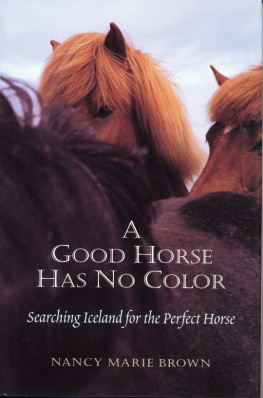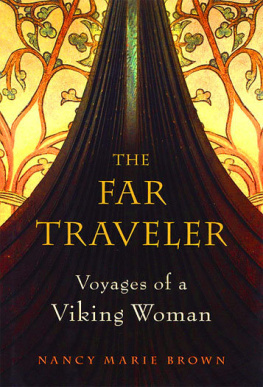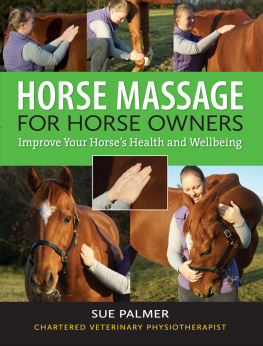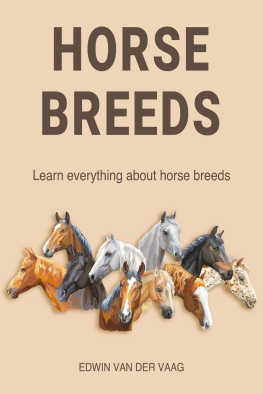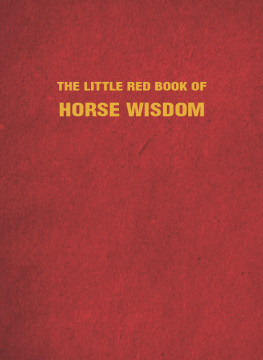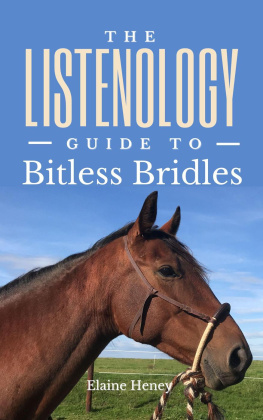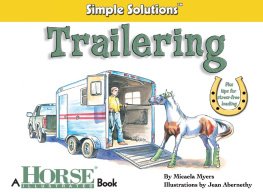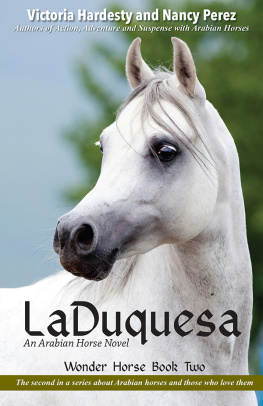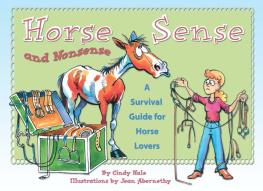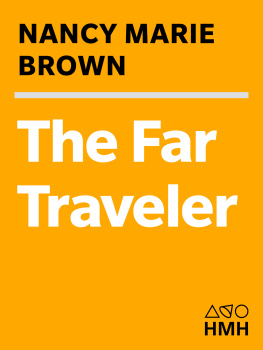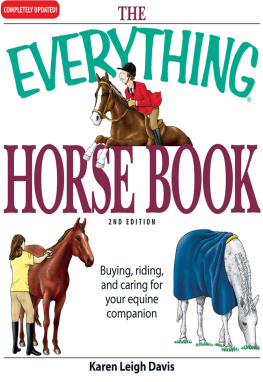ADVANCE PRAISE FORAGOOD HORSE HAS NO COLOR
A wonderful tale of a womans search for agood Icelandic horse that leads directly to self-discovery. NancyMarie Brown has woven memoir, adventure, Icelandic Sagas, andtravelogue into a book that will delight even those who dont findjoy on horseback. Mark Derr, author of Dogs BestFriend
The best journeys go two ways: out, into theunknown, and in, to what we might have known all along. Nancy MarieBrowns absorbing tale of looking for horses in Iceland is thatkind of odyssey. Like the ancient legends she recounts, hers isrich and transporting, a true saga. Melissa Holbrook Pierson,author of Dark Horses and Black Beauties
#
A GOOD HORSE HAS NO COLOR
Searching Iceland for the Perfect Horse
by
Nancy Marie Brown
#
Smashwords Edition
Copyright 2001 Nancy Marie Brown
First published 2001 by Stackpole Books
Electronic edition first published by theauthor in 2011
Smashwords Edition License Notes
This ebook is licensed for your personalenjoyment only. This ebook may not be re-sold or given away toother people. If you would like to share this book with anotherperson, please purchase an additional copy for each recipient. Ifyoure reading this book and did not purchase it, or it was notpurchased for your use only, then you should return toSmashwords.com and purchase your own copy. Thank you for respectingthe authors work.
#
CONTENTS
A Note on the Language
#
A NOTE ON THE LANGUAGE
S ince anIcelanders last name is generally his or her fathers name plusson or daughter (spelled dttir) and not a familyname, I follow Icelandic style in this book, using first names forall Icelanders.
I have anglicized the spellings of mostIcelandic words and names, changing the letters eth to d,thorn to th, and ash to ae, and omitting all accents, but,unlike many translators, I have retained most nominative endings.In the print edition, some Icelandic words appeared in italicscorrectly spelled, but the full Icelandic character set was notavailable to the author for this electronic edition, and so onlythe accents are included.
When trying to pronounce Icelandic words ornames, it helps to know that the stress is always on the firstsyllable and that lengthy words are usually compounds. The letterj is soft, making a y sound in Bjorn or fjord. The shsound is not common in the language; thus the Icelandic wordkeppnishestur should be read keppnis hestur, a show horse.Hestur is Icelandic for horse; the plural ishestar.
Many of the conversations in this book wereconducted in Icelandic, although my notes were taken in English.Such quotations, therefore, are both translations andreconstructions. I apologize to any Icelanders whose words I mighthave misunderstood.
#
I could hear thehorses before I saw them, their hoofbeats the high slap of cuppedhands clapping, beating the punctuated four-beat rhythm of thetlt, the breeds distinctive running-walk gait. From oursummerhouse, I watched them through binoculars. Pinpricks on thesilvery wet sand, they shimmered like a vision out of the IcelandicSagas, the medieval literature that had brought me to Iceland inthe first place.
Briefly the horses took shape as they cutacross the tide flatsnecks arced high, manes rippling, long tailsfloating behind. Their short legs curved and struck, curved andstruck. I would watch them until they disappeared beyond the blackheadland and wonder who their riders were, where they went on theirrapid journey.
I wanted to go with them.
Icelandic folktales warn of the gray horsethat comes out of the water, submits briefly to bridle and saddle,and at dusk carries its rider into the sea. For me, it was thewatcher who was carried away.
#
O ur summerhouse saton the edge of the sand, in a patch of tall grass fenced round bylava fields. It was called Litla Hraunin English, Little Lava. Myhusband, Chuck, and I, both writers, had rented it for thesolitude. It had seemed a grand place to sit tight and write bookswhen Id first found it, on a visit to Iceland four years before;yet when we finally arrived, in June of 1996, we were fleeing farmore than the common distractions of twentieth-century life.
Litla Hraun was a singular place of retreat.To the west its windows opened onto a long line of mountains, withnames like Horse and Buckets and Old Troll Wife, that marched downto Snaefellsjokull, the Snow Mountain Glacier, a stratovolcano atthe tip of the peninsula, whose cone seemed to float above the sea,coming closer on cloudless days. To the east, inland, we sawEldborg, the Fire Fortress, a spatter-ring crater that on hazy,rainy days faded eerily into the mist. Between the two mountains,between ice and fire, were wet pastures cut by swift rivers and oldvolcanic flows. The rock was black rubble or red heaps of stones,coated with golden moss or broken up by thickets of waist-highbirch. Where the hot lava had long ago rushed into the sea nowstood brittle headlands; on their cliffs and ledges kittiwakes andother gulls nested in swarms. Elsewhere the green pasturesstretched down to beaches, golden or black, shell-sand or volcanicash, littered with wrack. Sheep and cows grazed above the tideline, and bands of horses roamed along the shore.
The house had the amenities of a tent.Abandoned in the 1940s, before electricity made it out to thecoast, the three-room concrete box had no lights or running water.No road led to it: The gravel track petered out just past thegarbage dump at Stora Hraun (Big Lava), where Kristjan and Margretand their three children, and Kristjans twin sisters, and onesisters daughter kept two hundred sheep, fifteen milk cows, fourdogs, and three horseshalf wild, too old to ride. Between theirgarbage dump, where we parked the car, and our summerhouse lay amaze of tussocky pasture, salt marsh, bog, and tide flats, the mudof the flats grading into firmer sand cut here and there by tidalstreams. A large rock in the middle of the flats acted as our tidegauge. When it was fully exposed, we could walk across it in justunder twenty minutes, if we avoided what our eight-year-old son,William, named the sucky mud. When the rock was half underwater,we had to hike for an hour around the rim of the tidal zone, as thesand and mudand sometimes even the marsh, bog, and pasturewouldsoon be reclaimed by the rising sea. At dead low tide we couldbarely see from our windows where the ocean splashed white onto thebeaches to westward. When the tide was high, we looked out onto alagoon. At the full moon, the sea came in so close that for halfthe day we were cut off completely from our neighbors, with theirtelephone and washing machine, and from our car.
Yet those tidal flats between us and theapparent end of the road were themselves a highway. Nearly twice adaymore often on weekendsI would look up from my books or choresto see a string of horses, three to fifty in a group, purposefullycrossing the sands. Bays, chestnuts, sorrels, duns, pintos,palominos, blacks, whites, and grays. Horses as blue-black as ashor the dusty gray of the lava chunks. Reds and browns like dryearth, stream banks, shell sand, or clay. Light grays and yellowsand whites in shades from pumice to sulfur to chalk. And piebaldsand skewbalds and paints, like snow lying haphazardly on brokenground. All were the stocky, stout-legged Icelandic breed, the onlyhorse allowed in Iceland since the 1100s.
A man named Haukur Sveinbjornsson, I soonlearned, often led the riders over the sands, conspicuous on hiscream-colored gelding, Bjartur, whose name means Bright. Haukurlived at Snorrastadir (Snorris Homestead), the farm to the southof the lava field that was our backyard. His holdings included thelava and the crater of the volcano, Eldborg. He owned the mouth ofthe River Kalda, the Cold River, and the tidal islands on which seaeagles nested and seals sunned themselves. He had marshy hayfieldsand scrubby pastures, a barn full of milk cows, a flock of sheep,and a stable of some seventy horses.
Next page
